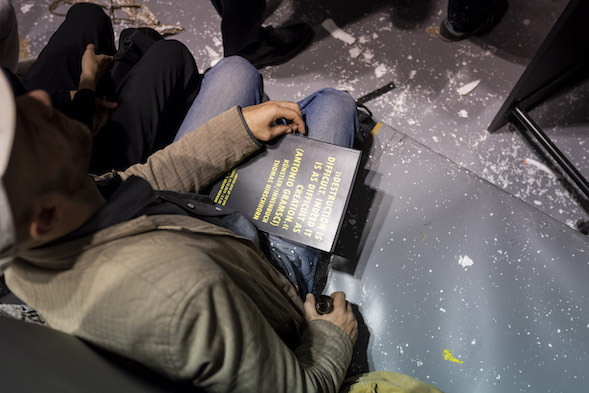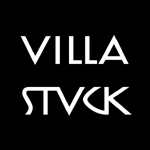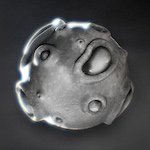
More and more public space of our streets, cities, and neighborhoods is shrinking; hence the question of extending and redeploying public space in the museum and in the public institution. I see this as a necessity and as something possible to achieve, but only if radical changes are made. Therefore, from my point of view I want to propose: 8 Conditions for The Museum of the Future.
- Public Space
The aim and mission of the Museum of the Future is the deployment or re-deployment of public space or moments of public space in the public institution. The deployment of public space the Museum of the Future needs a clear, serious and sober logic, the logic of Truth, of the Universal, of Justice and of Equality. This is the logic which opens towards the ‘non-exclusive audience’. The Museum of the Future will be a place to encounter art, philosophy and poetry. There will be no space for the ‘exclusive’, the consumable, for glamour, fashion, for what favors pleasing and consensual ‘cultural’ activities.
I reproach museums—in general—for not producing confrontation. I reproach museums for not believing in the autonomy of art and I reproach museums for not believing in the universality of art. A museum must believe and assert the intrinsic power of works of art in establishing a direct confrontation or dialogue—one on one. However, museums tend to offer less and less possibilities for a direct contact with art. Everything is designed to establish a distancing: through history, through communication, through culture. The museum considers its public as consumers instead of thinking each person as someone sovereign—solitary—who can confront and face a work of art in a direct dialogue, without other preconceptions. The tendency is to try to neutralize art through culture. Art is accepted when it possesses a ‘cultural surplus’. This ‘cultural surplus’ is a danger for the work of art. Tools (or guidelines) to avoid ‘cultural surplus’ are a true and uncompromising logic against the ‘exclusive public’ or ‘exclusive audience’, against everything ‘exclusive’ in general. The term ‘exclusive’ is continuously being used in art to argue, to intimidate, and to legitimize. ‘Exclusivity’ has become a positive criterion. On the contrary, art is inclusive; art never excludes. In other words, the ‘non-exclusive public’ is the opposite of a pre-determined, selected, and initiated public. It is essential that the Museum of the Future work towards a ‘non-exclusive public’, and it is necessary to touch—to create—a non-exclusive public and do so within the institution.
- Transformation of an event
The goal of the Museum of the Future is to create, through contact with art, philosophy and poetry the conditions for an event, and encourage its transformation which is the crucial point. This event, because it happens in the public space or within moments of public space, can lead to a transformation which is universal. This event provokes a displacement: a displacement in time. This displacement is also a displacement of what presence means, within this time. For instance, such displacement occurs when I am some place where I usually go and do something specific and—at some point—I am in that same place doing some other thing instead of the usual specific thing. This happens at a school gym during a vote, or at a workplace during its occupation for a strike.
The Museum of the Future will pose the question of presence—the presence of the body, of my body, of our bodies—and the question of time during which such presence of the body operates and creates an event.
This novel idea and this new postulate of a transformative event within the institution will become possible by presence and by production.
The Museum of the Future will assert that art—because it’s art—can transform each human being. The Museum of the Future will show art with energy in it!
- Open every day, 24/24
The Museum of the Future will always be open, at all hours (24/7), without closing hours, because art, philosophy, poetry can be a necessity any time, at all time. It could be necessary for somebody to get in contact with art, philosophy or poetry in the middle of the night. It will be a living museum, a real living space.
- Free access
Access to the Museum of the Future must be free for everyone at all time. The audience, the public, the ‘non-exclusive public’ gives Form with their presence and their production. They are therefore contributing and taking part in the form, and have paid with this act of production. The non-exclusive public constitutes the essential public, the one to conquer and to reconquer. The non-exclusive public, the heart (hard core), is an open public (‘open’ because open to an experience) composed essentially of people with free time, young or at the margins of society, and who participate by giving presence and production for reasons of their own. This open public understands that coming to the Museum of the Future is not about immediate consumption, satisfaction, or even about any satisfaction at all. This non-exclusive public must definitely be the hard core audience of the Museum of the Future.
- Presence and Production
The Museum of the Future’s guidelines are: Presence and Production. Presence and production are a gift, an offensive gift, given in order to provoke other presences and other productions. In the Museum of the Future, presence and production are the tools for creating public space. Public space is another term for presence and production, because only through presence and production can time and space be created, where the other is implicated.
This is a demanding alternative to the lazy, demagogic and so-called ‘democratic’ term ‘Participation’. I am not for ‘Participative-art’, because the first real participation is the participation of thinking! Participation is only another word for consumption! The artist, the philosopher or the poet have to give something first, in order to oblige the other (the non-exclusive audience) to give something (his/her time and his/her production). This is another distinction between ‘Presence and Production’ and ‘Participation’. I believe that throughout presence and production—my production and my presence first—the Museum of the Future can create involvement, implication, exchange, dialogue, confrontation, contact!
- Non-programming/Non-satisfaction
No more program or schedule is needed. Every event will happen unexpectedly. Non-programming is the guideline of the Museum of the Future. Non-programming is new and necessary because it allows keeping us awake and alert. Non-programming is the assertion that art, philosophy and poetry can create a dialogue and confrontation unexpectedly, without a program, without a schedule. An audience for art, philosophy, poetry can be created through production itself. Lectures, exhibitions, discussions, films, performances can run any time, and there will be no ‘previews’ or opening-announcements. It will be possible to walk into the Museum of the Future without a set ‚program‘ or predisposition. The open public understands and experiences first— because receptiveness is its specificity—the fact that non-programming is the novelty, the future, the key dimension of the future. It understands that one has to support, agree with, even wish for this non-satisfaction, which derives from non-programming. The open public understands that, through the state of non-satisfaction it can participate in the creation of an event. And above all, the open public understands—and is ready to experience—that an event without transformation is not an event. Transformation doesn’t take place unless non-satisfaction is experienced as resistance, which itself is transformation. Because non-satisfaction is a tool for resisting cultural, economic, political, religious, and social habits. Because art is resistance, resistance as such. This resistance makes transformation possible. The dimension of non-satisfaction allows the sketching of a new dynamic, a dynamic or movement in which a new form of public space is created or deployed—or redeployed. Visiting the Museum of the Future must be itself the event, the event to transform.
- No more ‚guards‘, no more ’security-persons‘
The Museum of the Future will have no ‚guards‘ or ’security-persons‘. Instead, everyone working in the Museum of the Future will consider himself as ‘first visitor’, with the task of transformation of the Museum. The ‘first visitor’ must be the one most interested, and most implicated, the biggest lover of art, philosophy and poetry. This is the reason for working in the Museum of the Future. The ‘first visitor’ will take care—in every possible way—to allow contact with art, to create the conditions to touch philosophy and to give a platform for poetry. This means that instead of security, the institution is present and first one concerned to stand for art.
- No more ‘Museum-Architecture’
The Museum of the Future has the ambition to offer a public space, to be a home or even a shelter. Therefore no more fancy, narcissist and useless ‘Museum-Architecture’ is needed.
Art does not need an ‚ideal‘ location to exist, art can shine wherever it is.
Thomas Hirschhorn, 2015
Tags: Thomas Hirschhorn



